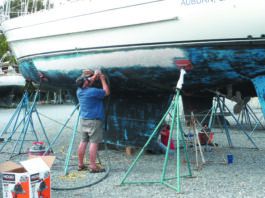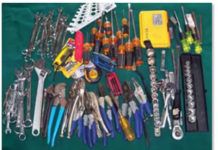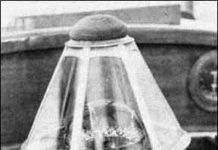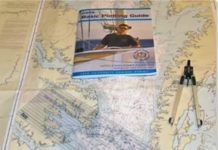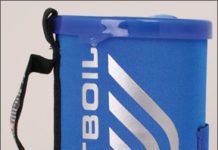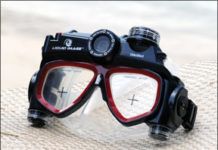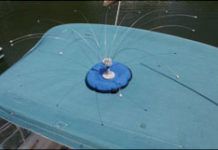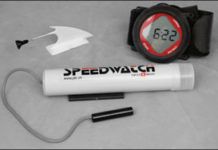Chandlery: August 2011
Practical Sailor Chandlery: August 2011. This month reviews a tiller, tool toter, and smart-phones.
Adjust Your Own Compass
With a little care, boatowners can do a perfectly adequate job of compensating their own compasses. The objective in compass adjusting is to neutralize the boat's magnetism, not to make the compass point in any particular direction. You can determine the effect of the boat's magnetic field on any compass bearing by simply turning the boat 180 for the amount that the compass overshoots or under‑shoots a 180' change is always just twice the effect of the boat's field on that heading.
Chandlery: June 2011
Although the ease and convenience of electronic chartplotters has ensured their place aboard most every vessel these days, the punch-and-go navigation that makes them so popular has also spawned a generation of slack-jawed zombies when it comes to even the most rudimentary of navigational skills. Prudent mariners continue to carry paper charts, both as backup to chartplotters (and their “one diode away from disaster” nature) and to have the big picture view that a plotter just can’t match.
The Complete Propane Appliance System
Of course, everything on a boat is a compromise, and so it is with propane. It has two nasty traits that must be dealt with: Propane is heavier than air, which allows the gas to collect in the bilge in the event of a leak; and propane is explosive when it collects in such places.
Hard-to-Find Mercedes Parts – Knotmeter Fouling
Given the number of Mercedes diesels you see on the highway, its amazingly difficult to find parts for the marinized versions of these engines. Part of the difficulty is the origin of the marine versions of the various Mercedes engines. Mercedes, like several other engine manufacturers, doesn't make marine diesels. They do, however, license other companies to do marine conversions using their engine blocks.
Update on 10 Long-term Practical Sailor Tests
As a publication that strives to give readers a thorough look at similar items competing in the marketplace, Practical Sailor's long-term testing is vital to determining product durability. Over the years, weve found various ways to update our views. Occasionally run a column called Gear Graveyard, and once in a while, we just round up products that have or havent stood the test of time. This is one of those roundups. All of the items mentioned are, or have been, in use aboard either a 26-foot biodiesel-powered inboard powerboat or a 32-foot Union cutter test boat. They are among quite a few items aboard that undergo testing and abuse, formal and informal, intentional and unintentional. The 10 items included in this report are the Plastimo flexible water tank, Seoladair Easystow inflatable fender, Garmin GPSMap 545s chartplotter, Coleman thermo-electric cooler, Jabsco oil changer, ACR Firefly 2 strobe light, Force 10 Seacook single-burner propane stive, FilterBoss, Aere inflatable fender, Boatsense systems alarm.
Chandlery: Practical Sailor Holiday Gift Ideas 2010
Every November, Practical Sailor editors celebrate the impending holiday season by reviewing gift ideas for the sailors on your list-or to add to your wishlist. This years wrap-up covers a range of interests and includes something to fit every budget. Looking for a new gizmo for the gadget junkie? Check out solar-powered, water-resistant Eton Soulra sound system, which can play most MP3 players and iPods, iTouch and iPhones while charging them. Or take a look at the SolarTech SolarPulse, a solar-powered device that charges and maintains a ship's batteries. The featured galley goodies from Galleyware and JetBoil will make practical gifts for those galley goddesses, and the Sailor's Solutions wireless remote switch for 12-volt devices is a good stocking-stuffer for creative boat owners and those looking for convenience.
The Liquid Image 310 Video Mask
For those of us who spend nearly as much time under the water as on it, the Liquid Image 310 video mask sounded like a great addition to our diving kit-and a good fix for our gadget addiction-so we had to give it a try when we came across it at a spring boat show.
Keep Birds Away from Your Boat and Dock
Practical Sailor tested a bevy of bird repellents to determine which are the most effective in keeping the pelicans, pigeons, cormorants, gulls, and other fowl from fouling your boat. Bird repellents fit into four basic categories: acoustical repellents, visual repellents, biochemical repellents, and those that use physical exclusion. Sailboats most commonly use visual devices, which are the easiest and most economical to use and install on boats. We installed a sampling of the various types and monitored them for six months. The test products included: Bird Barriers Scare Eye, Bird-Xs Terror Eyes, Bird Xs Prowler Owl, Bird-Xs Irri-Tape, Bird Barriers Polly-Spike, Bird Barriers Bird-Flight, Fly Byes Stainless Steel Wide Spike, Fly Byes Bird Umbrella, Bird Barriers Daddi Long Legs, Bird-B-Gones Bird Spider, Birdoffs Bird Off, WhirlyBird Repeller, Gull Sweep, and Bird-B-Gones Bird Deterrent.
Portable Sailing Tools for Tracking and Tuning Boat Speed
Practical Sailor recently spent a week experimenting with three handheld products geared toward performance sailors. These portable tools are for tracking and improving sailboat speed. Unlike conventional portable GPS units, which have relatively small displays and deliver a wide range of navigational data, these products display large digits that can be read from a distance, and the view options are limited to those that relate exclusively to speed and racing performance. Practical Sailor tested the Speedwatch and two GPS units, Velocitek SC-1 and SpeedPuck. These instruments make good training tools for young sailors and will give all around-the-buoy sailors the ability to quickly quantify performances.




































